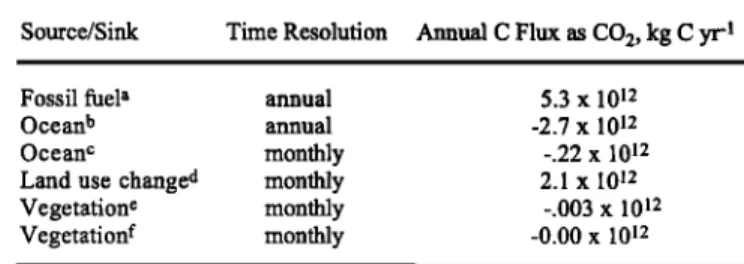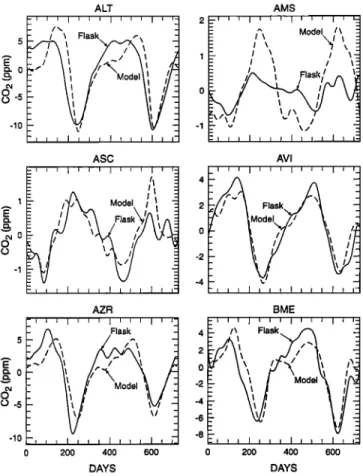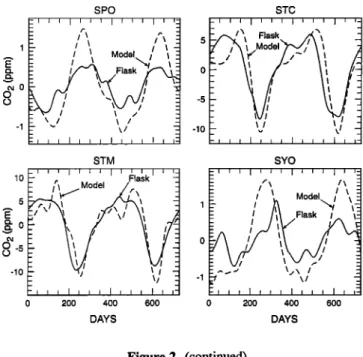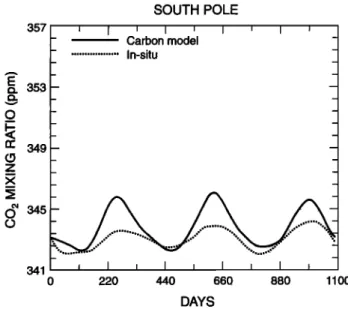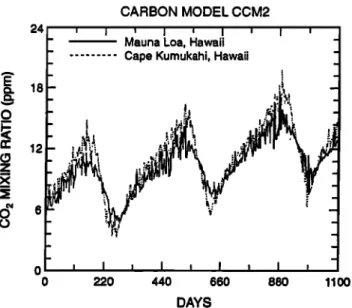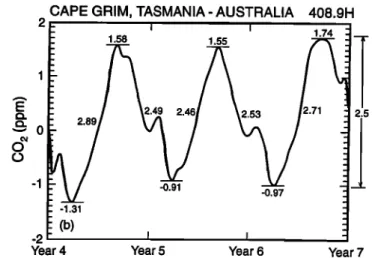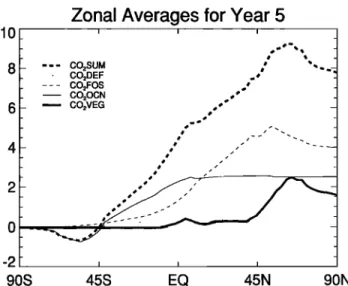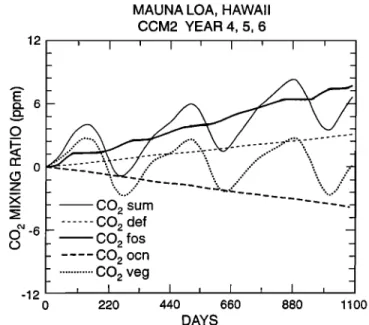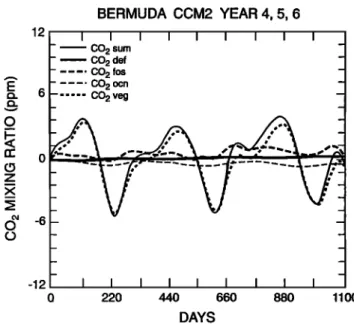HAL Id: hal-02923800
https://hal.archives-ouvertes.fr/hal-02923800
Submitted on 28 Oct 2020
HAL is a multi-disciplinary open access
archive for the deposit and dissemination of
sci-entific research documents, whether they are
pub-lished or not. The documents may come from
teaching and research institutions in France or
abroad, or from public or private research centers.
L’archive ouverte pluridisciplinaire HAL, est
destinée au dépôt et à la diffusion de documents
scientifiques de niveau recherche, publiés ou non,
émanant des établissements d’enseignement et de
recherche français ou étrangers, des laboratoires
publics ou privés.
The seasonal cycle of atmospheric CO 2 : A study based
on the NCAR Community Climate Model (CCM2)
D. J. Erickson Iii, P. Rasch, P. Tans, P. Friedlingstein, P. Ciais, E.
Maier-Reimer, K. Six, C. Fischer, S. Walters
To cite this version:
D. J. Erickson Iii, P. Rasch, P. Tans, P. Friedlingstein, P. Ciais, et al.. The seasonal cycle of
at-mospheric CO 2 : A study based on the NCAR Community Climate Model (CCM2). Journal of
Geophysical Research: Atmospheres, American Geophysical Union, 1996, 101 (D10), pp.15079-15097.
�10.1029/95JD03680�. �hal-02923800�
JOURNAL OF GEOPHYSICAL RESEARCH, VOL. 101, NO. D10, PAGES 15,079-15,097, JUNE 27, 1996
The seasonal
cycle of atmospheric COz: A study based
on the NCAR Community Climate Model (CCM2)
D. J. Erickson III,• P. J. Rasch,
2 p. p. Tans, 3 p. Friedlingstein,•,4
P. Ciais, 5
E. Maier-Reimer? K. Six,6 C. A. Fischer,• and S. Walters,•
Abstract. A global three-dimensional atmospheric model, the NCAR CCM2 general circulation model, has been adapted to study the hourly to yearly variability of CO2 in the atmosphere. Features of this CCM2-based model include high spatial resolution (2.8 ø x 2.8 ø latitude/ longitude), 18 vertical levels, a 15-min time step, and an explicit, nonlocal atmospheric boundary layer parameterization. The surface source/sink relationships used include exchange with the ocean, the terrestrial biosphere, biomass burning, and fossil fuel release of CO2. The timing and magnitude of the model seasonal cycle are compared to observational data for 28 sites. The seasonal cycle of atmospheric CO2 is generally well predicted by the model for most of the northern hemisphere, but estimates of the amplitude of the seasonal cycle in the southem hemisphere are overpredicted. To address this aspect more rigorously, we have used the
monthly surface oceanpCO2 maps created by the Max-Planck-Hamburg ocean general circulation model to asses the ocean seasonality on the atmospheric surface CO2 seasonality. The globally averaged interhemisphehc gradient in atmospheric CO2 concentrations, as cornputc•d with the chosen source/sink distributions, is a factor of two too high compared to data, and selected longitudinal bands may be up to 50% higher than the zonal mean. The high temporal resolution of this model allows the infrequent yet real extrema in atmospheric CO2 concentra- tions to be captured. The vertical attenuation of the seasonal cycle of atmospheric CO2 is well simulated by the boundary layer/free troposphere interaction in the model in the northern hemisphere. Conversely, an increasing amplitude of the seasonal cycle aloft is found in the midlatitude southern hemisphere indicating interhemispheric transport effects from north to south. We use two different models of the terrestrial biosphere to examine the influence on the computed seasonal cycle and find appreciable differences, especially in continental sites. A global three-dimensional chemical transport model is used to assess the production of CO2 from the oxidation of CO throughout the volume of the atmosphere. We discuss these CO + OH --> CO2 + H results within the context of inverse model approaches to ascertaining the global and regional source/sink patterns of CO2. Deficiencies in the model output as compared to observational data are discussed within the context of guiding future research.
1. Introduction
It is clear from experimental evidence that the atmospheric
concentration of CO2 has increased from-280 ppm to -350
ppm since the industrial revolution started about 1800 [Keeling et al., 1976; Raynaud et al., 1993]. One of the many aspects of the carbon cycle that is at present not sufficiently quantified is how and where the roughly 50% of the total anthropogenic CO2 released to the atmosphere has been absorbed by sinks on the Earth surface. There have been
arguments put forth for oceanic uptake as well as increased
carbon storage in the terrestrial biosphere [Bolin, 1960;
Broecker et al., 1979; Tans et al., 1990; Quay et al., 1992;
Melillo et al., 1993]. One of the most important constraints on the various global three-dimensional numerical simulations of the atmospheric CO2 cycle is the inter-hemispheric gradient [Denning, 1994]. Since most 2-D and three-dimensional
Copyright 1996 by the American Geophysical Union.
Paper number 95JD03680.
0148-0227/96/95JD-03680509.00
atmospheric models tend to overpredict the interhemispheric
gradient, it has been suggested that there may be a "missing"
sink in the northern hemisphere surface boundary flux
conditions.
Here, we describe a global three-dimensional atmospheric
CO2 model based on the semi-Lagrangian transport (SLT)
code in the NCAR (National Center for Atmospheric Research) community climate model, version 2 (CCM2). The main emphasis of this paper will be to introduce the salient aspects of the SLT/CCM2 transport model and compare the model predictions with atmospheric CO2 observations [e.g. Fung et al., 1983, Denning et al., 1995]. We compare the phasing and
amplitude of the model seasonal cycle of atmospheric CO 2
with the National Oceanic and Atmospheric Administration/
Climate Monitoring and Diagnostics Laboratory
(NOAA/CMDL) observations at 28 sites distributed globally [Conway et al., 1988; Thoning et al., 1989] and aircraft measurements over Cape Grim, Tasmania [Pearman and Beardsmore, 1984] and Sendai, Japan [Tanaka et al., 1987].
We examine two treatments each of the ocean and terrestrial
biosphere exchange of CO2 with the atmosphere.
15,080 ERICKSON ET AL.: SEASONAL CYCLE OF ATMOSPHERIC CO2
2. Model Description
The transport of moisture and tracers is done in CCM2 by
using a three-dimensional "shape-preserving" semi-
Lagrangian transport formalism [Rasch and Williamson,
1990a; Williamson and Rasch, 1989]. The transport scheme
was originally developed for the transport of water vapor in a
general
circulation
model
[Rasch
and Williamson
1990b;
1991]. More recently, it has been succesfully used for the simulation of stratospheric aerosol transport [Boville et al.,
1992], for the transport
of t4
C and the transport
of CFCs in
troposphere [Hartley et al. 1994]. We performed detailed tests
of the mass conservation of CO 2 and found that mass was
conserved to within 1% over 5 years. The F-11 tracer
experiments compare reasonably well with the Atmospheric
Lifetime Experiment/Global Atmospheric Gases Experiment
(ALE/GAGE) observational data with respect to seasonal
cycle amplitudes, variability, and year-to-year atmospheric accumulation [Hartley et al., 1994]. The shape-preserving transport algorithm can maintain very sharp gradients without introducing overshoorts or undershoots and diffuses only at the smallest scales of the model.
The planetary boundary layer (PBL) parameterization of
Holtslag and Boville [1993] is a nonlocal scheme based on
the work of Troen and Mahrt [1986], and Holtslag et al.
[1990]. The parameterization diagnoses the boundary layer
height and uses a prescribed profile of diffusivities below this
level. The parameterization includes the typical down
gradient diffusion as well as a less typical nonlocal transport term within the convective boundary layer (sometimes called a countergradient transport term). Above the PBL a local
vertical diffusion scheme is used. A parameterization of
momentum flux divergence produced by stationary gravity
waves arising from flow over orography is included, following
McFarlane [1987]. A simple mass flux scheme developed by
Hack (1993) is used to represent all types oœ moist convection.
The cloud fraction and cloud albedo parameteriza0ons are a
generalization
of those
of Slingo [1987]. The solar
?adiative
heating is computed using a delta-Eddington parameterization
with 18 spectral bands [Briegleb, 1992]. Sea surface
temperatures are specified by linear interpolation between the climatological monthly mean values of Shea et al. [1990].
Surface fluxes are calculated with stability dependent transfer coefficients between the surface and the first model level,
detailed by Holtslag and Boville [1993]. Both diurnal and annual cycles are included. Radiative heating rates are
calculated periodically and held constant between
calculations. Absorptivities and emissivities are calculated every 24 hours. Radiative heating rates are calculated every 1.5 hours. The land temperature is calculated by a four-layer
diffusion model with soil heat capacities specified for each
layer to capture the major observed climatological cycles. The land has specified soil hydrologic properties [Hack et al.,
1994].
3. Surface Boundary Fluxes
The uptake and release of atmospheric CO 2 with various surface boundary carbon reservoirs imparts a strong signal on
observed atmospheric CO2 concentrations on time scales
ranging from days to years. In our calculations we have selected the four main boundary flux conditions that are presently thought to be important for simulating the
variability of atmospheric CO 2 on daily to yearly timescales.
The terrestrial biosphere is one of the most important
components of the Earth system that influences atmospheric
CO2 concentrations on daily to seasonal timescales. The
ocean is thought to be important in the global CO2 budget on
seasonal to yearly timescales. Land use change, especially
biomass burning in developing countries, may contribute
significantly to the observed increase in atmospheric CO2
concentrations and we use a source term that has a weak seasonality. Fossil fuel combustion is the main single
anthropogenic source of atmospheric CO2 and we use a source that is without a seasonal cycle. The deforestation and
terrestrial biosphere fluxes are constructed from monthly means
that are interpolated to give daily values. Figure 1 shows the globally integrated net fluxes from each of our initial four source/sink parameterizations: fossil fuel and deforestation are both positive over the seasonal cycle; the ocean is a net sink
over
the seasonal
cycle
and the terrestrial
biosphere
imparts
the majority of the variability of the seasonal cycle and sums
to roughly zero over the seasonal cycle. Table 1 shows the
annual integrated net sources. Note that the sum of the global
fluxes does not add up to the atmospheric CO2 increase that
has been observed over the last decade, namely, 3.0 Gt (10 t2
kg) C yr 1, as observed from the NOAA global flask sampling network. The main emphasis of this work, however, is the
seasonal cycle of atmospheric CO2 and we are not concerned
here with decadel time scale changes in the mean atmospheric
CO2 concentration. We use the four surface boundary CO2
NET SURFACE FLUX FOR BOUNDARY DATASETS ... x ... t ... .t• ... i t ...
,,,..
- ,,\ I, - " - !I --2 -
\\
II
-
- --
fos
\\
. ."•-
.... ocn t •,. It- ---
de',
•-
.sum
, t
_
.... % I 0 180 360 DAYFigure ]. The net surface fluxes used in the initial version of
the model. The fossil fuel tracer is always positive and is assumed to be invariant over the seasonal cycle. The land use change (deforestation) tracer is also always positive and has a slight seasonality. The ocean is a net sink for atmospheric
CO•_ and •s also assumed to be co•stam over the seasonal
c•cle. Note that the largest temporal forcin; o• the
atmosphe•c CO• bud;et •s •m the te•es•al b•osphere.
ERICKSON ET AL.: SEASONAL CYCLE OF ATMOSPHERIC CO2 15,081 Table 1. Annual Magnitude of the Global Source/Sink Terms
Used in Model Runs
Source/Sink Time Resolution Annual C Flux as CO2, kg C yr -1
Fossil fuel a annual 5.3 x 1012
Ocean b annual -2.7 X 1012
Ocean c monthly -.22 x 1012
Land use change d monthly 2.1 x 1012
Vegetation e monthly -.003 x 1012
Vegetation f monthly -0.00 x 1012
aMarland and Rotty [1984].
bBroecker et al. [1986] pCO 2 field with a 14C consistent transfer velocity.
CMax-Planck-Institute far Meteorlogie-Hamburg (MPI-H) three-
dimensional ocean model.
dlncluding Biomass Burning, blueller [ 1992].
eFung et al. [ 1987].
fFriedlingstein et al. [1992].
flux estimates summarized in Figure 1 in our initial model runs and compare and contrast the results from these runs with
additional model runs employing the Friedlingstein et al.
[1992] terrestrial biosphere model and the Max-Planck Institute (MPI-Hamburg) ocean model.
ocean temperature, salinity, total inorganic carbon, and alkalinity [Weiss, 1974]. It is straightforward to see that the
sense of the air-sea flux is determined by the deviations of
pCO2so
from pCO2*. When the surface
ocean is
undersaturated with respect to the atmosphere, the flux of CO2
is into the ocean; when the ocean is supersaturated with respect to the atmosphere, the converse is true. It is important to note that there is substantial uncertainty in the global
distribution of both pCO2so and K w [Etcheto and Merlivat, 1988; Erickson, 1993]. The global mean transfer velocity has been made consistent with the observed oceanic uptake of 14C
produced by nuclear testing.
The partial pressure of CO2 in surface ocean waters (pCO2)
is a complicated function of several different physical, chemical, and biological processes. It is important to note that several recent experimental studies have observed much variability in the surface ocean CO2 content [Watson et al.,
1991; Wong and Chan, 1991]. While it is currently believed that the main source term that influences the seasonal cycle of atmospheric CO2 is the terrestrial biosphere, in the southern hemisphere there may be an important seasonal forcing due to the ocean. This will be the topic addressed when we compare and contrast the atmospheric CO 2 results obtained from using
two different ocean treatments.
3.1. Terrestrial Biosphere
The atmosphere exchanges carbon with the terrestrial
biosphere on a variety of time scales, one of the most
prominent being the seasonal cycle. In the phase 1
calculations we have used the monthly global grids described
by Fung et al. [1987]. These global source/sink terms sum to roughly zero for the annual cycle. In addition, note that each element of the terrestrial source/sink grid sums to approximately zero over the annual cycle, Table 1. The overall seasonal cycle of all source/sink terms is clearly dominated by
variation in atmosphere-terrestrial biosphere CO2 exchange.
In a section below we compare the model runs of the Fung et al. [1987] sources with those ofFriedlingstein et al. [1992] with particular emphasis on the amplitude and phasing of the seasonal cycle at middle-high latitudes of the northern
hemisphere.
3.2. Ocean
The ocean has long been known to influence the
atmospheric concentrations of many trace gas species. The
distribution of the partial pressure of CO2 (pCO2) in the
global surface ocean is one of the important factors in modeling air-sea CO2 transfer (Sarmiento and Sundquist,
1992). In these calculations we have used the annual mean
pCO2 grid of Broecker et al. [1986] and a monthly model estimate of pCO2 produced by the Max-Planck-Institut far
Meteorologie, Hamburg, ocean GCM. The pCO2 grid has been
converted to a flux map via the application of a 14CO2 consistent transfer velocity, as described in Equation (1)
F = K w [pCO2*- pCO2so] (1)
where F is the net flux and may have units of umol cm -2 h-•
when
Kw
is the
transfer
velocity
(cm
h-l),
p CO2'
is the partial
pressure of CO 2 in surface sea water in equilibrium with an
atmospheric CO2 wet mixing ratio of 350 ppm (gmolecules
cm-3) and pCO2s o is the measured or modeled CO2 partial
pressure in surface ocean seawater (umol cm-3). Note that
pCO2* is a nonlinear
solubility-related
function
of surface
3.3. Land Use Change/Biomass Burning
The release of carbon to the atmosphere from land use
changes, mostly conversion of tropical forest to cropland or
pasture (including biomass burning), has been accounted for
by using the global distribution of these processes as
described by Mueller [1992]. The total annual flux is
estimated as 2.1 Gt C per year. Note that in the time series of
the four different sources over the annual cycle (Figure 1) there
is a slight seasonality in the land use change emissions,
largely related to the amount of precipitation over the tropical forest regions. Clearly, most biomass burning is occurring in
tropical regions of developing countries such as Brazil
[Woodwell et al., 1983]. The small negative values represent
those areas that have been altered by mankind and are
presently regrowing as cultivated crops or new forest growth.
3.4. Fossil Fuel
The flux of CO2 to the atmosphere associated with the
combustion of fossil fuel is an important component of the contemporary cycle of atmospheric CO 2 [Keeling, et al., 1976;
Marland and' Rotty, 1984]. Based on experimental and
modeling evidence, the observed increase in atmospheric CO2 is primarily due to the addition of-5 Gt C (as CO2) yr-• being added by the fossil fuel source [Revelle and Suess, 1957]. Here, we use a source function that is invariant in time over the annual cycle. The annual flux that we have used in this
work is 5.3 Gt C (as CO2) yr-1 [Rotty, 1987a, b]. The source term is known to be somewhat seasonal in character [Marland and Rotty, 1984]; however, this variability is thought to be of
the order of 10-20% and we do not include the monthly
variability in these first numerical experiments with the model.
4. Model Diagnostics
The model has been run for 6 years with the output data
archived every 12 hours. We have selected years 5 and 6 as
15,082 ERICKSON ET AL.' SEASONAL CYCLE OF ATMOSPHERIC CO2 ALT / \ Flask. _ r, ½u i / -5 -10 v ' ASC : I t : I t
• 1 •
/•
Model
I t
o [ / o • / -, -1 AZR • Flask -l.,k=
1-,-,
-
• Model o '10 Y• • • I • • • I • • • I • E 0 200 400 600AMS digital filter with a frequency cutoff for detrending of 0.5
/^•
•
cycles
smoothingyr
-1
was done in a similar way with the cutoff frequencyfbr
both
the
data
and
the
model
output.
The
\\
ii
• set to 18.25 yr-1 We then subtract.
the local mean from the two/?%.
i
Flask/r,
!• treated
data
sets
to get
Figure
2. The general
characteristics
of
both data and observations are larger (>5 ppm CO2) seasonal amplitudes of CO2 in the northern hemisphere and smaller (<5
ppm CO2) in the southern hemisphere.
Table 2 shows the amplitude of the modeled and observed AVI seasonal cycle for each of the 28 stations plotted as function of
-'''
•'''
•'''
•' '- latitude
and
summarized
in Figure
3. The seasonal
cycle
i//A •
Flask --amplitudes
the southernin
hemisphere.the
northern
hemisphere
The Cape Meares, Oregon, Stationare
much
larger
than
in
•'
tMødelx'//
•
-
(45øN,
124øW),
shows
the
influence
of sector
sampling
on the
/
/
subsequently
derived
seasonal
cycle. The observations
are
=
• t
• /= restricted
at this
station
to conditions
when
the
winds
are
_ \
i •V •x• fromoffthe
Pacific
so
asto
sample
amarine
,background
,
-• • • I • • • f • • • I • •= condition. This explains why the summer 'drawdown' of
BME atmospheric CO2 due to the increased activity of the terrestrial
.... •''' •''' •' ': biosphere as computed by the model does not appear so
=-
/.//•1\
•
Flask'x••
strongly
in the observational
record. This is a common
feature
• //.•/' •
/,
of several
of the
experimental
sites. In southern
hemisphere
•x•; XModell
/; regions
as comparedthe
model-computed
to the observations. In a section below, we useseasonal
cycles
are
overestimated
•/
V the
seasonally
varying
surface
ocean
pCO2
field
of
the
MPI-H
_ ocean general circulation model to drive the atmosphmic
_
:, , • I • • • I , • • I • •= model. In section 4.1 we will discusss in detail the seasonal
0 200 400 600 cycles at selected geographically representative stations.
DAYS DAYS
Figure 2. The CCM2-based carbon cycle model predicted
atmospheric CO 2 concentrations compared with the National
Oceanic and Atmospheric Administration/Climate Monitoring
and Diagnostics Laboratory (NOAA/CMDL) observational data for 28 sites around the world. See Table 2 for location
information. Day 1 corresponds to January 1.
comparison with observational data. The seasonal cycles in
atmospheric CO2 mixing ratios at a variety of observational
stations are compared with the model predictions. The
o 0-5 -10 BMW
_-'
,/• Flask.x• 10
/•'
\\•
;•Model\t
/ 5
- o -5i
IV
V '10
BRW _ -- /• _-• /1, Flask /\,
--=_
CBA CGOcomputed
interhemispheric
gradient
inatmosphcric
CO?.
and
b''' •'''
•'''
•' 'd I•''' i,,,
•,,, •, '•1
the
of altitude
phasing
and
are
amplitude
also
discussed
of
the
within
seasonal
the context
cycle
as
a
function
of the
•o
• /•Flask_
I= t\ .Model
•./
"It I 1
•- .?'\, .Flask
observations.
• i••
•,•.//'•
• • o
-14.1. Seasonal Cycle Simulations -•o -3
We
have
selected
28 stations
with
which
to objectively
compare
the
model.
The
CMDL
data
used
for comparison
with
½HR
½MO
the
model
output
for
years
5-6
are
from
1989
and
1990.
Th• =_--
/• xFlask
• 10
observational
data
years
selected
for
comparison
to the
model 2___ Model
I •
• 0
were
chosen
to be
relatively
free
of obvious
climate
c•li/'L•5 ) l/"x
"anomalies"
such
as
E1Nino
orPinatubo
anddisplay
amore
!i,j'
••
//xf•x
I .10
or less
"climatological"
character
that is appropriate
for o• 0
•
•
examination
of
seasonal
cycles.
In
some
cases
the
years
used
-1
= •/
•X• -20
were
different
from
1989
and
1990
due
to the
incompleteness
---,,
i I,, r I r r, I, ,a -30
of the observational
data during
this period. In those cases,
0
200 400 •00
0
200 400 •00
the nearest 2-year time series at the station was used in the DAYS DAYSmodel-data comparison. Figure 2 shows the model-data
ERICKSON ET AL.: SEASONAL CYCLE OF ATMOSPHERIC CO 2 15,083 GMI • 0 0-2 /
ø
-4d
¾
_ -,,, I • • I• i • I • •- KUM • w//Model •4 kr•'\ ' Flask
x.
VJ//%\
\ _-
0-2 MID 6 Model• 4 • j • flask
%o 0-2 -4 -60 20o 4oo 60o
DAYS lO 5 o -5 -lO KEY [ I i , I I ] I- _ ask"--,.¾,X^ \
the residuals for the NOAA/CMDL observations. The vast
majority of the residuals are within 1 ppm in the model run as well as in the data, which is encouraging. In addition, there
appears to be a clear seasonality in the model residuals that
appears to some extent in the data. This seasonality has enhanced variability in the late winter-spring seasons that maybe related to transport issues [Harris and Kahl, 1990; Harris et al., 1992]. This 12-hour timescale variability
-,• I• • • I,• • I• r indicates the possibility of up to 3-4 ppm variability in MB½ atmospheric CO2 concentrations that are related to the local
r\/Model
-- synoptic
scale
meteorology.
Indeed,
a power
spectrum
of the
/•i '/ •\
} \'• ],,,-'
\i
model
significant
output
power
as
in
well
the
3 to
as
4-day
the
observational
band.
data
show
4.1.2. Bermuda. Bermuda (33øN, 89øW) is generally
downwind from the North American continent, which has strong terrestrial biosphere and fossil fuel emission signals.
The seasonal cycle of the model and data are presented in
Figure 6. The detrended model predictions are in reasonable
MLO
--- Flask----*/'• --
L//•\/..-Model
///,
1 _--
0 200 400 600
DAYS
agreement with the observations with the amplitude of the seasonal cycle averaging about 8.7 ppm. The observational data show a somewhat anomalous spring-summer minimum in
1991 that does not appear in the model. This could be related
to interannual variability in the source/sink terms in the real world that are not included in the present model formulation. Note that the fall 'bump' in the observational data is also replicated by the model and is related to a seasonal release of carbon from the terrestrial biosphere as well as an enhanced
transport of fossil fuel CO2 during this time period. This
Figure 2. (continued)
4.1.1. Mauna
Loa. Figure
4 shows
the model-observation e
compari,;on, smoothed and detrended, for three annual cycles at Mauna Loa (19.5øN, 155.6øW). Here, to facilitate the
interpretation
of climatological
seasonal
cycle,
we smooth
by
• 0
averaging
every
7 days
and
then
fit a cubic
spline
to the c•.2
resulting
points. This removes
much
of the shorter
timescale
variability
present
in Figure 2. The seasonal
cycle is
dominated by the uptake and release of CO2 by the terrestrial biosphere, resulting in a seasonal cycle (peak-to-peak amplitude) of about 6 ppm (Table 2). The phasing of the seasonal cycle is in reasonable agreement with theobservations, with several stations being offset by a few weeks to a month. Note that in Figure 2, using the Fast
Fourier Transform approach to get the amplitude of the
seasonal cycle, the computed amplitudes are somewhat higher than in this analysis. The relative difference between the model and the observations is still roughly 1 ppm CO2. This points out that great care must be taken in using a variety of statistical methods to analyze both model output and data,
especially when comparing results between diverse research
groups.
An important
test
of model
variability
is the ability of the c•
model
to replicate
the deviations
of individual
events
from o-s
some long-term mean. The model is run at a 15-min time step -10
and we choose to save a three-dimensional model 'realization' every 12 hours. Figure 5a shows the high-frequency residuals
from a smooth seasonal cycle for the CCM2 model run, as
computed from a cubic spline curve fit, and Figure 5b shows
NWR - /•1 /C• •'/,•.•'•- Model rff i l •
i • -'
Flask
//
PSA _ I"'\• Model /'"\ ---:
///•i /Flask
i I \, i
-- /j • \ 1/ RPB SEY 10 Slim _ 0 200 400 600 DAYS SMO / Flask _ 200 400 600 DAYS Figure 2. (continued)15,084 ERICKSON ET AL.' SEASONAL CYCLE OF ATMOSPHERIC CO2 1 •0 o 5 0-5 -10 SPO STC
:''' I 'r'' I''' I ' '
// \\
/•'\
5
Flask•
•/\\
-
, \ Model.
,' ',
•" //'"•,•/Mode,
_/•/' •
•
- • /
x/
•/ •
_ STM - Flask - _ _ 0 200 400 600 DAYS SYO z ,"\ /\ --r- /
/ \•
__ / \ Model i \ - -"'
---
\.z\ /
\/ o 20o 400 600 DAYS Figure 2. (continued)aspect of the model-data comparison is discussed in greater detail in a section below.
During the third year of the model-data comparison it is
obvious that the observational data show a much stronger drawdown of atmospheric CO2 during the spring-summer period than occurs in the model or the preceding two years of the observations. We intentionally include this feature in our
analysis to emphasize that the interannual variability of the real Earth system is large. We speculate that the drawdown of atmospheric CO2 at Bermuda during this particular year is related to the changes in the surface sourcesink relationships
that year as opposed to changes in atmospheric transport.
An interesting and significant aspect of this new model is
the possibility of modeling the high-frequency variability of
atmospheric CO2 concentrations. Bermuda allows us to look closely at this aspect of the model. Figure 7 shows the
observed, weekly variation in atmospheric CO2 concentration
as measured at the Bermuda (west) station. In addition to the pronounced seasonal cycle there are several 'outliers' that are several ppm less than the mean trend. Back trajectories calculated for these occurrences suggest a circulation pattern in the summer whereby a parcel of air is advected rapidly from the photosynthetically active regions of midlatitude northern
hemisphere regions to Bermuda, thereby preserving some of
low CO2 signature caused by photosynthesis. Figure 8
shows the model predictions for Bermuda and the infrequent yet real instances where parcels of CO2-depleted air are arriving at Bermuda during summer clearly stand out.
Therefore the model is capturing these high frequency
variations that exist in the experimental data. Also note the 'positive' outliers in the data, mostly in fall and winter, and model predictions that represent the short timescale advection
of 'polluted' air parcels from the industrialized regions of North America. This kind of detailed analysis of the model performance highlights the importance of using short timescale transport information (hours) in order to interpret certain
aspects of the observational record.
Table 2. Comparison of Seasonal Cycle Amplitudes in the Three-Dimensional Model With Observations
Site Latitude Longitude Elevation, m Model Observed
Alert, 82 ¸ 272q 62 ¸ 3 l'W 210 17.45 15.34
Ascension Island 7 ¸ 55'S 14 ¸ 25'W 54 2.51 2.25
St. Croix, Virgin Islands 17 ¸ 452q 64 ¸ 45 W 3 6.60 7.46 Azores (Terceira Island) 38 ¸ 452q 27 ¸ 05'W 30 12.11 12.72
Bermuda (east) 32 ¸ 222q 64 ¸ 39'.W 30 10.22 10.99
Bermuda (west) 32 ¸ 162q 65 ¸ 53'W 30 10.22 12.20
Point Barrow, Alaska 71 ¸ 19N 156 ¸ 36'W 30 20.20 17.40
Cold Bay, Alaska 55 ¸ 122q 162 ¸ 43'W 25 17.31 16.52 Cape Grim, Tasmania 40 ¸ 41'S 144 ¸ 41'E 94 2.29 1.15
Christmas Island 2 ¸ 002q 157 ¸ 19'W 3 2.83 3.39
Cape Meares, Oregon 45 ¸ 292q 124 ¸ 00'W 30 30.79 11.22
Guam 13 ¸ 262q 144 ¸ 47'E 2 6.26 7.79
Key Biscayne, Florida 24 ¸ 402q 80 ¸ 12'W 3 8.47 8.70
Cape Kumukahi, Hawaii 19 ¸ 312q 154 ¸ 49'W 3 9.17 8.98
Mould Bay, Canada 76 ¸ 142q 119 ¸ 20'W 15 18.07 17.27 Sand Island, Midway 28 ¸ 132q 177 ¸ 22'W 4 10.70 10.09
Mauna Loa, Hawaii 19 ¸ 322q 155 ¸ 35'W 3397 6.09 7.45
Niwot Ridge, Colorado 40 ¸ 032q 105 ¸ 38'W 3749 9.70 9.59 Palmer Station (Anvers Island) 64 ø 55'S 64 ¸ 00'W 10 3.13 2.03
Ragged Point 13 ¸ 102q 59 ¸ 26'W 3 5.98 7.62
Seychelles (Mahe Island) 4 ¸ 40'S 55 ¸ 10'E 3 3.66 2.99
Shemya Island 52 ¸ 432q 174 ¸ 06'E 40 21.74 18.99
American Samoa 14 ¸ 15'S 170 ¸ 34'W 3 1.91 1.66
Amundsen Scott (south pole) 89 ¸ 59'S 24 ¸ 48'W 2810 2.47 1.14
Ocean Station "C" 54 ¸ 002q 35 ¸ 00'W 6 17.47 14.15
Ocean Station "M" 66 ¸ 002q 2 ¸ 00'E 6 19.82 15.22
ERICKSON ET AL.' SEASONAL CYCLE OF ATMOSPHERIC CO 2 15,085 4O 30 < 20 o 10 A Model [] Observed I I Bm A [] [] -90 45 0 45 90 Latitude
Figure 3. The zonal mean of the amplitude of the seasonal cycle plotted for the 28-station model-data comparison shown
in Figure 2. Note the decreasing amplitude of the seasonal
cycle from north to south.
MAUNA LOA, HAWAII (Detrended)
358 • I ' I ' I • I ' Carbon Model ... Observed 356 355.48 355.39 ..,-..
,•.._•__•.
'
•f/••5 354.99
99-./•
354
I•Z •15.65 //5.81 [ t 5.17 //6.4•t 5.53 •352
6
351, .
349
349.00
348.81
347 I
•
I
•
I
•
I
•
I
,
0 220 440 660 880 11 O0 DAYSFigure 4. The detrended and smoothed seasonal cycle for 3 years from the model run and the CMDL/NOAA in situ data at Mauna Loa, Hawaii. The model results are from years 4, 5, and 6 of the model integration and the observational data are from 1989, 1990 and 1991. Note that the model and observations agree quite well with respect to the amplitude with the model underestimating the summer drawdown by about 0.7 ppm.
CCM2 MLO RESIDUALS (From Dash-dot Curve)
1994 1995
fill lilll Ill IIIIIIIIIIllllllllll I
ß .'..j.:.•4. ,.. :1
:•: 2:' ,,•..•r,•:
,. •:. : TI
,
q
,.
'....•
.P,
!
:'i
IIIIIlllllll
II Ill III;111111111111
II
1996 1997
Figure 5a. The residuals of the CCM2 model predicted
atmospheric CO2 concentrations for 3 years of model run at
Mauna Loa, Hawaii. Note that the model has a clear
seasonality in the distribution of residuals with much more
variability in the first 6 months of the year.
4.1.3. South Pole. Figure 9 shows the model-data compariso'ns for the seasonal cycle at the South Pole station, 90øS. Clearly from this detrended analysis, the amplitude of the model seasonal cycle is roughly a factor of 2 too large compared to the data. The phasing of the seasonal cycle data, however, is good. It is possible that the CO2 sink in the southern oceans is highly seasonal, changing the amplitude of
the annual cycle observed at the South Pole and other remote
southern hemisphere stations. It is interesting to note that the
model tendency to overestimate the seasonal cycle in the
southern hemisphere is also observed in the three-dimensional modeling study using observed winds [Keeling et al., 1989a,
b; Heimann and Keeling, 1989; Heimann et al., 1989]. In a
section below we present a detailed analysis of the individual
MAUNA LOA OBSERVATION RESIDUALS (From Smooth Curve)
3 Illlllllll IIIIIIII1111111111111111111111111111111] IIIIIIII I
2 : .-. . ,, . ... ., ß
,:.; ',,.-..., ....:,
L.L.I..< ?'..: ½ .,:'4: :' !:&'. :,•. .... ;.•..., .. z :. --...': <, ß • .. ,.,• x ß . . ß • .: ' + . . -2 989 1990 1991 1992 YEARFigure 5b. For comparison with Figure 5a the residuals of the observational atmospheric CO2 concentrations for 3 years at Mauna Loa, Hawaii. Note that the model has a similar seasonality in the residuals as the observations.
15,086
ERICKSON
ET AL' SEASONAL
CYCLE OF ATMOSPHERIC
CO2
BERMUDA (Detrended)361
f ' I ' I ' I ' I ' ' t
Carbon model ... Flask data 357 356.49 356.57 35.•.53P -7•
355.571•
•'"•'•'56.23 -1
• • d":'• • •• • 0 356
353
8.3
i 9••
0•[.
12
13••9••••
• 352
• •8
349F
a.e.•
•7.21
•
•7.20
•347p•q
[
345 •0 341 I • I • I I I • I • / 364 • BERMUDA CCM2 YEAR 4, 5, 6 0 220 440 660 880 1100 DAYSFigure 6. The detrended and smoothed seasonal cycle for 3 years from the model run and the CMDL/NOAA flask data at
Bermuda. The model results are fi'om years 4, 5, and 6 of the model integration and the observational data are from 1989, 1990, and 1991. Note the model and observations agree quite well with respect to the amplitude of the seasonal cycle and that in the third year of the comparison the large (---5 ppm) difference between the model and the data emphasizes the climatological nature of the model forcing as contrasted with the natural variability of the real Earth system.
model component tracers that result in the model-data
differences and examine the influence of a seasonally varying
ocean source/sink formulation (MPI-Hamburg) upon the computed atmospheric seasonal cycles.
,,
I • I i I
0 220 440 660 880 1100
DAYS
Figure 8. The time series of the 12-hour model predictions for Bermuda. Note that as in Figure 7, there are a few very low
atmospheric CO2 values during the summer. This may be
interpreted as an indication that parcels of CO2-depleted air
may be advected from the North American continent to Bermuda before substantial mixing can occur. The model is
capturing this infrequent yet real atmospheric phenomena.
forcings applied [Heimann et al., 1989]. To examine this
aspect of our model, we have compared and contrasted the
model output for a sea level station, Cape Kumukahi (19.5øN,
154.8øW), with the Mauna Loa Station at 3400 m. Figures 10a
and 10b show the seasonal cycles for both the CMDL
observational data and the model output at Cape Kumukahi
and Moana Loa. The amplitude of the seasonal cycle of the
SOUTH POLE
4.2. Vertical Phasing and Amplitude of Seasonal Cycle 4.2.1. Mauna Loa and Cape Kumukahi. One of the interesting tests of model performance is how the tracer concentrations vary in the vertical in response to the surface
355 350 BERMUDA, FLASKS 370 iIiiiiiiil[11111111111[1111111111!llllllllllll[1111111111 365 o• o o o ø •5 o o 0 1990 • 99• • 992 • 993 • 994 YEAR
Figure 7. The weekly flask data of the CMDL/NOAA .group at
Bermuda. Note the very low atmospheric CO2 values that
occur once or twice a summer.
357
nE 353
0 rr 349 Z X 0 345 341 - Carbon model - - ß ... In-situ _ - _ - _ - _ - _ - _ - _ _ _ 0 220 440 660 880 1100 DAYSFigure 9. The smoothed and detrended seasonal cycle for 3
years from the model run and the CMDL/NOAA flask data at
the south pole. The model results are from years 4, 5, and 6 of the model integration and the observational data are from 1989, 1990, and 1991. Clearly, the model overestimates the amplitude of the seasonal cycle of atmospheric CO2; however,
the phasing is quite good. We discuss the results of a
atmospheric model run using an alternative ocean forcing in a
ERICKSON ET AL.: SEASONAL CYCLE OF ATMOSPHERIC CO2 15,087
FLASK DATA
362 l ' I ' I ' I ' I [' /
r- •
Mauna
Loa,
Hawaii
•]
• ...
Cape
Kurnukah,,
Hawaii
#• j
359
..':
•
,.
,i:'
':--
352
348 0 220 440 660 880 1100 DAYSFigure 10a. The seasonal cycle for 3 years from the
CMDL/NOAA flask data at Cape Kumukahi, Hawaii (3 m
above mean sea level (amsl)) and Mauna Loa, Hawaii (3400 m
amsl). The observational data are from 1989, 1990, and 1991.
Note that the Cape Kumukahi data always fall slightly to the left of the Mauna Loa data, indicating a phase shift of a few
weeks.
model output for Cape Kumukahi is within 0.2 part in 9 of the observed seasonal cycle (Table 2). The CMDL flask data for
Cape Kumukahi (3 m above mean sea level (amsl)) and Mauna
Loa (3400 m amsl) provide some interesting information (Figure 10a). The Cape Kumukahi observational data fall to
the left of the Mauna Loa which indicates that the lower-
elevation station experiences the terrestrial imprint on the atmospheric CO2 concentrations a few weeks before the middle
CARBON MODEL CCM2 4.809H 15.07H 32.55H 63.95H 99.04H 158.7H 189 1H 251.2H '•324 8H 408.9H 501 2H 598 2H 695 1H 786 5H 866 4H 929 2H 970,4H 992 5H Year 7
(• CO•
mixi?cj
_r?_[io
Mo•.•no
Loo,
Howoli
iDe[rent[d
o
•
Year 8 Year 9 Year 10
Figure 11. The vertical distribution of atmospheric CO2 concentration, detrended, for 3 years at the model grid point of
the Mauna Loa Observatory. Note the general decrease of the
amplitude of the seasonal cycle with increasing altitude,
except at the top of the model.
troposphere station, Mauna Loa. The amplitude of the
seasonal cycle at Cape Kumukahi is also -•25% larger than the amplitude of the seasonal cycle at Mauna Loa. Figure 10b
shows the comparison between the Cape Kumukahi Station and the Mauna Loa Station as computed by CCM2. As in the data, the Cape Kumukahi atmospheric CO2 concentrations lead the Mauna Loa concentrations by a few weeks. Also, the amplitude of the seasonal cycle is -35% larger at the lower- elevation station, in the same sense as the the observational data. The model is representing the vertical attenuation of the impact of surface forcing quite well. Figure 11 shows the time evolution over 3 model years of the vertical CO2 concentration, detrended, for the location of the Mauna Loa Observatory. Note the decrease in amplitude with increasing altitude with a small increase in seasonality at the top of the
model domain.
24 ' I ' I ' I
Mauna Loa, Hawaii Cape Kumukahi, Hawaii
E 18
v it :. ,'• 0 ..g .•t
,!4•
•,
•'"' •.
,.
12
, • • •..."..
..,': ,
..v
,:
10
• . ß '; : ;z
ø
i
.,:...
, , ... 1
0
0 •.0 440 $60 880 11000
¸ -5
DAYS -10Figure 10b. The seasonal cycle for 3 years from the NCAR
CCM2 at Cape Kumukahi, Hawaii (3 m amsl) and Mauna Loa,
Hawaii (3400 m amsl). For comparison with Figure 10a, note -15 that the Cape Kumukahi model predictions always fall slightly
to the left of the Mauna Loa model predictions, similar to the observational data.
4.2.2. Sendal, Japan. We have examined the vertical attenuation of the seasonal cycle of CO2 over Sendal, Japan
(38øN, 140øE). Figures 12a and 12b show the detrended
model seasonal cycle for 3 years at -930 mbar and -410 mbar.
•SENDAI
929.21-;.I
I
-- 7.47 _-
_- 6.02
6.87
_
- 15.88 -
Figure 12a. The detrended
model seasonal
cycle of
atmospheric
CO2 at the model
surface
level for Sendal,
Japan.
15,088
ERICKSON
ET AL.: SEASONAL
CYCLE OF ATMOSPHERIC
CO2
SENDAl 408.9H CAPE GRIM, TASMANIA-AUSTRALIA 408.9H
4
2
.
-4
Year
4
Year
5
Year
6
Year
7
Year
4
Year
5
Year
6
Year
7
Figure
12b. The detrended
model
seasonal
cycle
of Figure
13b.
The
detrended
seasonal
cycle
of
atmospheric
CO2
atmospheric
CO2
at
the
--410-mbar
level
for
Sendal,
Japan.
The at the
-•410
mbar
level
for
Cape
Grim,
Tasmania
The
mean
mean
amplitude
of the
seasonal
cycle
is -•8.4
ppm
CO2,
roughly
amplitude
of the
seasonal
cycle
is -•2.5
ppm
CO2,
roughly
20%
a factor
of 2 less
than
at
the
surface
(Figure
12a).
greater
than
at the
surface,
Figure
13a.
The
amplitude
of atmospheric
CO2 at the surface
is roughly
16.6 ppm. The small 'shoulders' during the first few months of
the
year
are
due
to transport
processes
in the boundary
layer
interacting
with the surface
emission
patterns.
Figure 12b
shows the detrended seasonal cycle at --410 mbar. The
amplitude
of the seasonal
cycle
in atmospheric
CO2
is 8.4 ppm,
roughly a factor of 2 smaller than at the surface station. This i s the same trend as seen at the two Hawaii stations. Forcomparison with some observational data, Tanaka et al. [ 1987], report seasonal cycle amplitudes in the lowest 2 km of the atmosphere of---14.2 ppm and 8.0 ppm at ---410 mbar. This
indicates
that the boundary
layer proccesses
are working
adequately near the Asian continent as well as in the remotePacific, as indicated by the analysis for Mauna Loa.
4.2.3. Cape Grim, Tasmania. The seasonal
cycle
in the
southern
hemisphere
has
been
seen
to be substantially
smaller
than in the northern hemisphere, based on both observationsand models.
At Cape
Grim,
Tasmania
(40øS,
144øE),
Figures
13a and 13b show the derrended
model
amplitudes
for two
vertical levels, 930 mbar and 410 mbar. Figures 13a and 13b-2
CAPE GRIM, TASMANIA- AUSTRALIA 929.2H
1.8••-•
I 1.85
I 1.99
•
• -0.13
-0.35
.05
(a)
I
I
Figure 13a. The detrended
seasonal
cycle
of atmospheric
CO2
at the model surface level for Cape Grim, Tasmania. The mean
amplitude of the seasonal cycle is ---2.1 ppm CO2.
show the seasonal cycle at the surface to be roughly 2.1 ppm, whereas at 410 mbar it is actually larger by ---20%, 2.5 ppm.
This is exactly opposite what is observed and modeled at the northern hemisphere sites. This is due to the fact that the
transport of northern hemisphere CO2 to the southern hemisphere occurs most efficiently in the middle troposphere,
an aspect verified by observational data [Pearman and
Beardsmore, 1984] and replicated in the modeling study of
Keeling et al. (1989a, b).
4.3. Interhemispheric gradient. The interhemispheric
gradient of atmospheric CO2 is closely linked to the
magnitude and spatial distributions of the surface source/sink
terms. To first order, the large--5.3 Gt C (as CO2) source to the atmosphere from the combustion of fossil fuels occurs primarily in the northern hemisphere and one would expect the northern
hemisphere annual mean CO2 mixing ratio to be higher than
the southern hemisphere. However, this expectation should
ZONAL AVERAGES FOR YEARS 4, 5, 6
13 , • , • , • , 12 - -180 to -90 , I \ 11 ... 90 to 0 • • -
